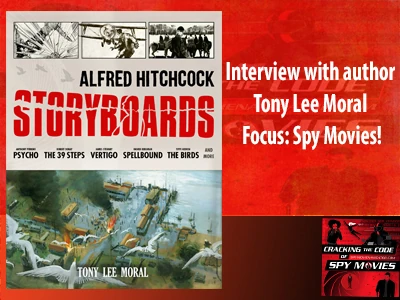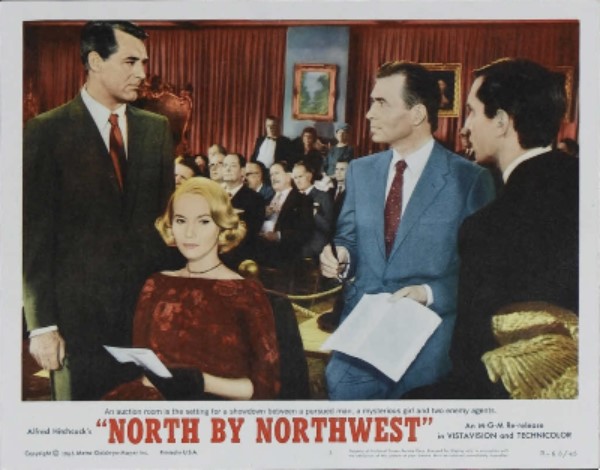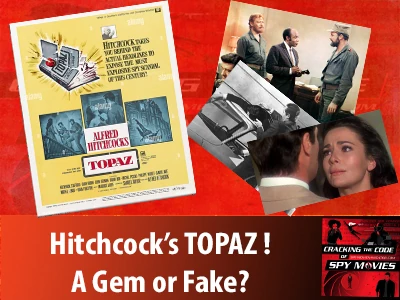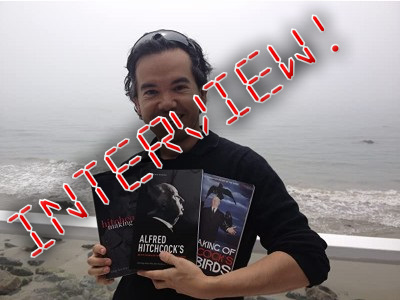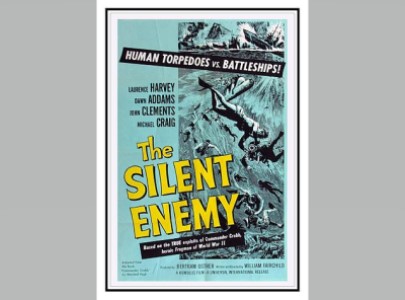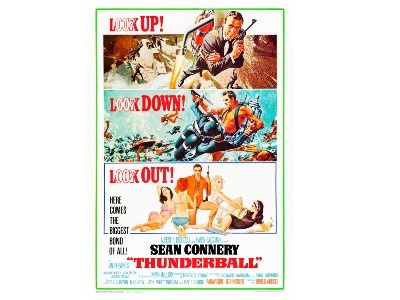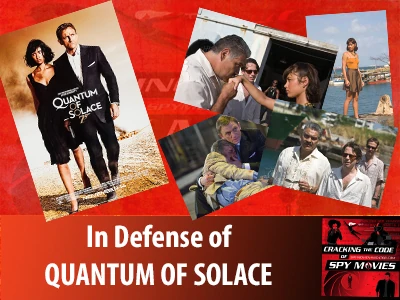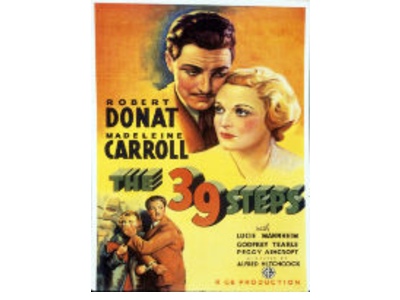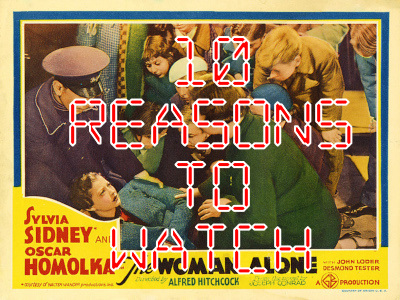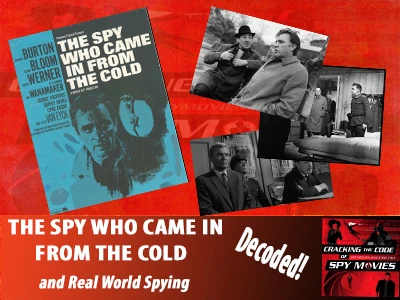The 39 Steps
Hannay – Robert Donat
Pamala – Madeleine Carrol
Miss Smith – Lucie Mannheim
Professor Jordan – Godfrey Tearle
Director: Alfred Hitchcock
Summary on Wikipedia
The 39 Steps, directed by Alfred Hitchcock, released in 1935, is considered by many to be the first spy film. So, if you are a spy movie fan, then we must take a close look at The 39 Steps to see exactly what this film is about, how it may have influenced other spy films to come, and what happenings in the real world influenced this spy film. As in many Hitchcock movies, like North By Northwest, Notorious, The Man Who Knew Too Much – an innocent bystander is thrust into the world of espionage.
A woman agent who has no affiliation with any country is trying to stop England’s secrets of air defense from falling into the hands of some certain brilliant agent of a foreign power who wants these secrets. Not because she loves England, but because they will pay her better. This is what she tells Hannay – that at the theater where they had just come from, there were two men who wanted to kill her. She and Hannay went back to Hannay’s flat. And he looks to the street from his flat window, he sees two men – waiting. She tells Hannay that he is in just as much trouble as her now – and if he ever heard of The 39 Steps. Their chief has a dozen names and can look like a 100 people, but the one thing he cannot disguise is he has the top part of his right-hand little finger missing. She wants a map of Scotland because that is where the man she must visit next is.
This film stars Robert Donat and Madeleine Carrol.
If you are a spy movie fan, you can watch the entire 1935 film on YouTube.
More Details
The film opens in a theater, in London, where a man on stage is about to answer virtually any questions the audience may ask. He is, in a sense, Mr. Know-It-All, called in the film Mr. Memory, who every day commits to memory 50 facts in a variety of categories (science, history, geography, etc.). There is a haunting musical theme that is associated with Mr. Memory that sticks in Hannay’s head.
A man walks in in a trench coat and sits down. Later a woman is shown at the bar. The man in the trench coat, who turns out to be Hannay, asks how far Winnipeg is from Montreal – and Mr. Memory indicates that the gentleman is a Canadian. So, we see he is not a Brit. After a bunch of questions, an official-looking gentleman comes in (police) and there is a scuffle with a guy at the bar. During the commotion, Hannay finds himself face-to-face with a woman. After a while, she asks if she could go home with him. He says, “well, it’s your funeral.” Spoiler: He turns out to be correct.
They leave the music hall and go to his place, 122 (looks like) Portland Place: Portland Mansion. He has a furnished flat as he is from Canada here for only a few months. He asks her name: “Smith.” She looks Eastern European, has an accent – Smith? Ok, now we are a little suspicious of her and who she is.
The Death of the Spy
Hannay sees Smith come into his room in this flat, with a piece of paper, stumbling, and saying, “You’re next!” She falls, revealing a knife sunk halfway into her back. She collapses and dies. Hannay does not know what to do next. The local police think he has killed her – it was in his flat. And he flees, remembering what she said about Scotland.
Not so easy to get out of his flat. The men are still there waiting for him now.
Hannay’s Getaway from his Flat – the Milkman Scene
Because Hannay is now being watched – and he does not know who wants to get him – the police for the murder he did not commit, or the people who killed the spy – he must devise a clever way to get out of his flat. The milkman scene is a classic, and we see other bait and switch scenes in future spy moves too, like in James Bond’s The Living Daylights where the enemy spy kills the milkman, then disguises himself as the milkman so he can get into the safe house where a Russian agent is kept who are defecting to the West. Here, Hannay needs the milkman’s uniform as a disguise to try to escape the two guys waiting to kill him.
The Trains Scene, Flying Scotsman
He heads for the train, the Flying Scotsman. In this clip, we see the death scene, but cuts to the train scene – Hannay is aboard and two are in pursuit of him.
This is the first of many train scenes (chases, fights, key meetings) we will see in spy movies to come! (Just a few to think about: Secret Agent, From Russia With Love, Live and Let Die, The Spy Who Loved Me, Octopussy, Mission: Impossible 1, Casino Royale, Skyfall, and others). Here, for the first time, is the original chase scene on the train – with tense moments, intense drama, and a man, Hannay, trying to escape from the officials who are after him, who think he killed the woman spy in his flat.
Just pay attention to the clanging of the wheels, the lighting on the train, the bridge, the pursuit – all part of the blueprint for future spy movies. Two gentlemen read a newspaper across from him on the train about the murder and how Hannay is wanted by the police. The police are aboard the train after a stop and are looking for him. He enters a compartment and kisses a strange woman, who turns him in – but later becomes an ally after a while. The bridge in the movie is the Forth Bridge in Scotland, which opened in 1890, and it is still around and can be visited. The foot chase on the train creates tension and distress. Hannay, while innocent, is trying to escape. The chase is a foreshadowing of future chase scenes and fight scenes on trains as we will see in Spy Train, From Russia With Love, The Spy Who Loved Me, Octopussy, Mission Impossible 1 and others. His escape to the bridge, Forth Bridge, is electrifying and for the viewer, a relief. The train is stopped on the bridge as the police look for him. This somewhat foreshadows View to a Kill bridge scene in San Francisco for Roger Moore’s Bond. Here, the police re-board the train thinking Hannay got back on, but Hannay did not.
Wandering now around Scotland, he stops and talks to a man, and asks if there are any newcomers around – he says yes an Englishman, a professor, and yes, he is near the town that the spy was to go to. Hannay must stay the night at this farm, meets the man’s wife, who misses Glasgow where she is from. He flatters her. She seems to like him. This scene is important because, as Hannay reads the newspaper he sees that the murder has been traced to Scotland. He knows they are on him. The wife knows that he is the man they are after. In fact, she awakes in the middle of the night, her husband notices, and she tells Hannay the police are coming and he better hurry. The husband thinks they are making love, but he tells the husband the police are after him and pays the man 5 pounds. But when the police come to the door, the wife knows her husband will turn Hannay in. Margaret (she reveals her name) gives him her husband’s “Sunday” coat.
With police still in pursuit, he runs. A small helicopter is looking for him too – ah, remember we will see more helicopter pursuits in spy films, like in From Russia With Love! He runs and is running along a river – the Forth Bridge transverses the estuary (Firth) of the River Forth – so this is probably the River Forth, not far from Alt-Na-Shellach (now we think it is called Achnashellach) – a large estate that he was looking for.
Hannay finds the estate, rings the bell, asks for the Master, and says to ask him if he knows Miss Annabella Smith (the spy). He enters, the police show up, and the maid answering the door denies any strangers are there. Hannay introduces himself as Mr. Hammond and he is from Miss Smith. The people know about the murderer being in Scotland, so know he is Hannay and asks if Annabella was killed and why he is here in Scotland. He says she was coming to see you. That the foreign agent who killed her is headed up by a man who had part of his little finger missing. He reveals that part of his (Professor Jordan ) little finger is missing and that he is about to convey some very vital information out of the country.
He shoots Hannay, and he falls. Turns out the bullet hits the hymnbook that was in the farmer’s “Sunday” coat. Hannay escapes to the sheriff. He turns him into the police who have been after him. The other two men who killed Smith are outside the police station. Hannay escapes through the window. He loses himself in a parade and the woman on the train (Pamela) turns him in again and Hannay tells her to call England and Scotland Yard. She says no. She and Hannay are in a car being taken somewhere. It is a suspicious situation. Pamala and he are now wondering – and Hannay says I bet your Sherriff principal has the top joint of his little finger missing. Pamela overhears something that makes her believe Hannay is telling the truth.
Handcuffed together, Pamela and Hannay escape.
The police are still on his tracks as he stays at an inn with Pamela and they show up to ask the innkeeper about new travelers. But they are supposedly in the good graces of the wife and she sends off the police. Pamala now decides Hannay has been speaking the truth. Eventually, they make it back to England. The haunting Mr. Memory musical theme is still in Hannay’s head as he has been whistling it in various scenes. Is Pamela the first Spy Girl (ala “Bond Girl”)? If so, she is tough and self-sufficient, and a model for future spy women. Think Ursula Andres as Honey Rider in Dr. No.
For spy movie fans, this movie has continuous action – not the kind of special effects action scenes in modern spy films – but continuous action that creates tension onscreen and in the viewer’s mind.
The Theater Finale
Back in London, Pamela goes to Scotland Yard – she had phoned from Scotland (unbeknownst to us). Scotland Yard is not believing her. They want Hannay. She goes to the theater. They follow. Hannay is in the theater too. The tension is police are following her to get to Hannay. Hannay sees someone up in a box, borrows specs and sees a hand with the top knuckle of the little finger missing!
Mr. Memory is now on stage! Hannay figures it out – Mr. Memory has committed all the secret plans to memory and Hannay thinks Professor Jordan will get him out of the country after the show. Hannay is cornered by the police and he shouts out to Mr. Memory, ”What are the 39 Steps?” Mr. Memory starts to speak, “The 39 Steps is an organization of spies collecting information on behalf of the foreign office of . . .” and he is shot by Professor Jordan, who leaps from the box and eventually onto the stage (ala John Wilkes Booth) and is caught. Hannay: “Mr. Memory – what is the secret formula you were taking out of the country?” Mr. Memory: “The first feature of the engine is….renders the engine completely silent.” And he dies. The secret is safe! Hannay is innocent!
